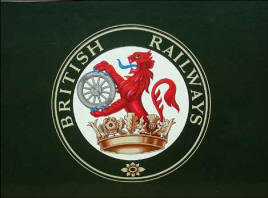
Home
List of Locomotives
List of
Rolling Stock
List of Other Inclusions
Download
**unavailable**
Project Team
FAQs
Site Design ©2006 Worley Web
Design - Graphical Set distributed under the GPL License
[ www.tt-forums.net
] - [
www.ttdpatch.net ]
|
Electric
Locomotives
These are
the Electric Locomotives of Great Britain. From the first introduction of a
mainline straight electric locomotive in 1958 through to the latest design -
the Class 92 used for cross-channel runs - Britain has led the way in
Electric Locomotives. The set hopes to showcase this with a selection of the
most famous locomotives in BR History.
Note that livery lists
are NOT exhaustive.
Electro-Diesel Locomotives
 |
Class 73
The Class 73 was intended to be used as a way of pulling trains over
a route that was partly non-electrified without the need to change
locomotives. It operated off 750kW third-rail power, and was
intended for use for trains beginning or ending in the South East.
However, it's low diesel engine power meant it rarely strayed from
the South East Region. 73s are in good use today, being employed by
GBRf. Several are in use as "Thunderbirds" - rescuing failed EMUs.
They were designed in 1962
Eurostar, EWS, FM Rail, Gatwick
Express, GBRf, Merseyrail, Network Rail, SouthWest Trains |
 |
Class 74
A more powerful edition of the 73, but it had a much more complex
changeover system and became unpopular. It was also found
unnecessary on the routes it was built for and quickly became
obsolete. The class was introduced in 1958 as the class 71, but was
refitted with a diesel engine to ensure use "off-the-juice" - all of
these locmotives were withdrawn by 1977.
BR Green, BR Blue |
Electric
Locomotives (Overhead Catenary Collection)
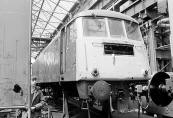 |
Class 81
These locomotives were used on the West Coast Mainline and were
designed in 1959 at Birmingham Coach and Wagon, Smethwick. They were
the first straight electric production locomotives. They were used
on the newly-electrified West Coast Main Line and operated passenger
and goods trains. They lasted until 1990.
BR Blue, Intercity Swallow |
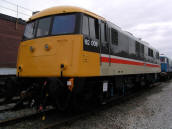 |
Class 82
The 82 was designed in 1960. It was classed as AL2 and was used on
early services on the West Coast Main Line. They were all withdrawn
in 1983, but two were in use until 1987 on empty coaching shunting
between Willesden and London Euston. One is preserved.
BR Blue, Intercity Swallow |
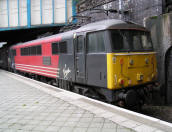 |
Class 86
These were the "standard" locomotive of the 60s, deriving from
earlier test versions. 100 of these were built to operate the first
electrified lines - between London Euston and Manchester Piccadilly,
Crewe and Liverpool Lime Street. Later, they were used on
cross-country routes with Virgin. 86s are now often used on freight,
with several owned by Freightliner working in pairs.
BR Blue, EWS, Anglia, Intercity
Swallow, Trainload Freight, Railfreight Distribution, RES,
Freightliner Grey, Freightliner Green, Network Rail, Virgin
Red/Black
|
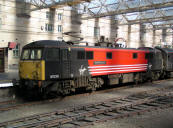 |
Class 87
The 87 was built in 1973, intended to run the West Coast Main Line
following the electrification north of Crewe and Preston. They were
originally dedicated to passenger trains but following privatisation
one - the unique 87/1 - was acquired by EWS. Also, after large scale
withdrawal by Virgin, several fell into the hands of Great British
Railfreight, who use them on occasional mail services and to rescue
failed 325 parcel EMUs. There are also several stored at the
Ministry of Defence barracks at Long Marston.
BR Blue, Cotswold Rail, LNWR Black,
Virgin Red/Black, Portersbrook Purple, DRS, GBRf, NSE |
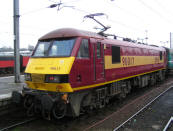 |
Class 90
The fastest freight train ever to run on British Rails, but also one
of the weakest. With a meagre 258kN of Max Tractive Effort, it has
only half the pulling power of the Class 59. However, it is not used
for heavy mineral or slate trains, instead being used for lighter
container freight. This allows it to run to an immense 110mph, with
certain wagons. This locomotive also pulls passenger trains - Virgin
had a large fleet until 2004.
EWS, Freightliner Grey, Freightliner
Green, GNER, RES, Railfreight Distribution, One/Anglia, Virgin
Trains, Intercity Swallow |
 |
Class
91
The mainstay of the East Coast Main Line. The Class 91 heads a rake
of mark 4 passenger coaches and Driving Van and runs between London
and Edinburgh. This train can hit 140mph, but only a short section
of the ECML allows this. Otherwise, it is limited to 125. Introduced
in 1989, they were originally intended to run passengers in the day
and intermodals at night, but this plan came to nothing as logistics
became a problem.
GNER, Intercity Swallow |
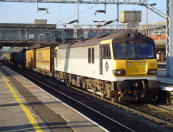 |
Class 92
An express freight train that is far more geared to pulling power
than speed. It's 90mph is slower than the 110mph of the Class 90,
but this brute has an incredible 7000hp and 400kN of maximum
tractive effort. This is the new pride of the British Rail system -
with several of these examples crossing through the Channel Tunnel.
EWS own several, but only two actually have full EWS liveries. They
were introduced specifically for Channel Tunnel use in 1993.
SNCF Grey, EWS Badged, EWS Full |
Back to Top -
Back to Locomotives
|









